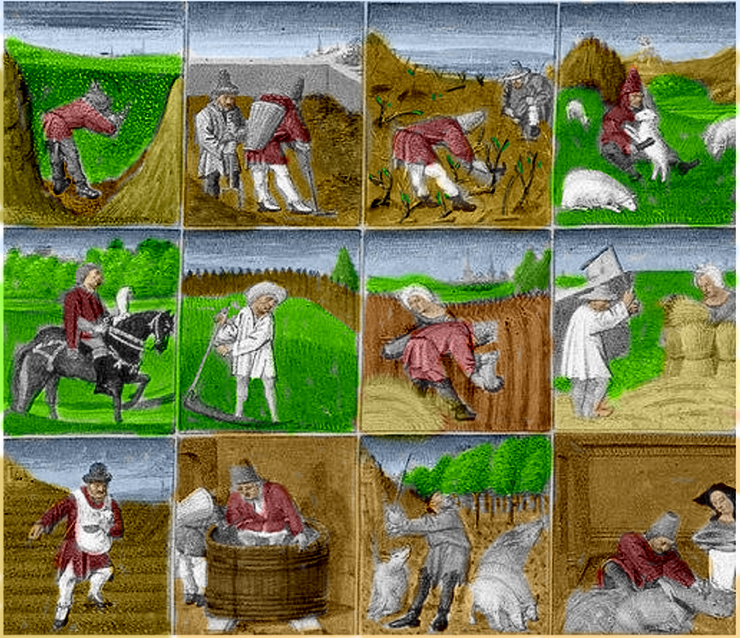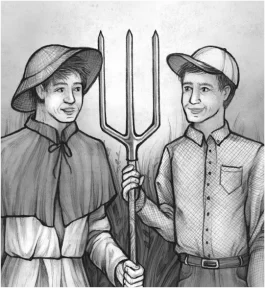Read by Michael Flamel

In increments of two or three minutes at bedtime each night, I’ve been reading A Distant Mirror, Barbara Tuchman’s bestselling history of 14th century Europe. What better respite from the pressures of modern life, I thought, than to be carried back into the remote past and marvel at such a different place and time?
One of the illustrations in the book is Pietro Crescenzi’s calendar (left) that depicts the chores of medieval peasants throughout the year: preparing soil, sowing seeds, pruning fruit trees, tending animals, stomping grapes.
The image is iconically medieval, yet eerily familiar. I’ve spent my spring days starting seeds, turning soil, making compost, working on the chicken coop, and doing other chores just like the ones in the picture.
Looking into the pages of a history book, I saw myself. “Distant Mirror” is right! Suddenly it struck me: I’m not a mild-mannered suburban homeowner. I’m a peasant!
How did this happen? The medieval peasantry spent centuries struggling to cast off the feudal yoke, and here I’ve gone and voluntarily yoked myself to my garden. What began a few years ago as a harmless hobby—growing a few tomatoes and salad greens in a small community garden plot—has spiraled out of control into a big suburban yard filled with garden beds, a fruit orchard, a beehive, and a henhouse. I may not be bound to the land by serfdom, but I can’t take a vacation for more than a few days without finding someone to come by and water. And apart from my primary responsibilities of working, parenting, and taking long bike rides, I spend most of my free time toiling in the garden.
Realizing that I’m a peasant came as a shock, because the word has such negative connotations in our culture. While real peasants were widely diverse in time, place, and circumstances, the basic historical meaning of the term, according to reputable online dictionaries, is “an agricultural worker who owns or rents a small plot of ground” or “a member of a European class of persons tilling the soil as small land-owners or as laborers.” That doesn’t sound so bad, but it’s taken on a figurative meaning, too. Nowadays, “peasant” can refer to “a coarse, unsophisticated, boorish person of little financial means.”
Despite this stereotype, I have come to accept my peasanthood as a lifestyle choice that works for me. This is not to romanticize the life of a medieval peasant, which seems rather nasty, although the members of the class ranged from the abjectly poor to the fairly prosperous. I’m what you might call a cafeteria peasant, choosing the aspects of peasantry that sound like fun while keeping many benefits of modern city life. Let’s run through the menu. Own a small plot of land and grow much of my own food? Check. Miserably hard life, working mostly for the local lord, with only a little time to tend my own field, and sometimes, according to Tuchman, being “crucified, roasted, or dragged behind horses by brigands to extort money?” Pass. Boorish, uncultured, crude? I hope not, but I guess all you meatheads will be the judge of that.
Little financial means? OK, check. But all the garden produce takes a big chunk out of the grocery bill, so we peasants can get by on less. That’s why the term still describes those of us who forgo some of the luxuries of the consumer culture in favor of more simple pleasures like growing and eating fresh food and spend-ing less time in offices and more time in gardens. I’m a suburban, part-time hobbyist peasant, but a proud peasant nonetheless.
Why would anyone willingly accept this pejorative label? Well, compare the images of peasants and aristocrats in old paintings. Who looks healthier and happier? The kings and nobles are decked out in fancy robes and jewels, but they don’t seem very pleased about it. Their tastes may be refined, along with their flour and sugar, but their luxurious lifestyle just makes them look cranky, bloated, and gassy.
By contrast, peasants are often shown toiling in the fields, but in many paintings they look fit and happy, feasting and partying in simple homes at tables piled with food. They worked hard, but as Tuchman describes them, they produced their own eggs, cheese, onions, garlic, vegetables, rye bread, honey, beer, and cider. All this, and they avoided the diseases of affluence that afflicted the rich cake-eaters.
I don’t mind being associated with peasantry, and not just because I’m in my own Middle Ages now. I also feel comfortable with the role because my favorite foods—root veggies, garlic, cabbage, and dark leafy greens—are the staple ingredients of peasant dishes like hearty soups and stews. It’s not surprising that this wholesome diet has found its way into gourmet restaurants. Append the word “cuisine,” and the stigma mysteriously vanishes. Peasant cuisine has all the virtues that the foodies of today love. It’s local, wholesome, seasonal, healthy, and delicious. “Peasant” is even the name of an upscale eatery in New York City. How odd that we disparage peasants while celebrating their food.
Logically, if we find peasant food healthful and enjoyable, shouldn’t we also embrace the lifestyle that produces it? If it’s good to eat like a peasant, I think it’s good to live like one, too. Of course, there is some irony in voluntarily and selectively imitating the way of life that was forced upon the real peasants. I’m doing for leisure what they did instead of leisure.
My desire to create a significant amount of my family’s food may have tethered me to my little suburban virgate (the old English term for the amount of land needed to support one person). But aren’t we all dependent on the industrial food system, which might be called “foodalism”? We are like vassals in this system, working in exchange for inexpensive food. But the price of our fealty is that in the process of producing huge quantities of cheap food, much of the flavor and nutrition is removed, not to mention the humanity. Something the peasants of yore knew all about.

So I’m staging my own little Peasants’ Revolt. The goal is to keep all the good progress that’s been made since the Black Death, while acknowledging the cost that our prosperity has for our health and the environment, and recovering some of the positive traditions that have been lost. Growing some veggies in a garden, however small or large, is not only a hobby that’s so much fun it can take over your life. Gardening is also a way to stake out a delicious measure of independence from our foodal overlords.
Power to the People—uh, Peasants! ❖


 Previous
Previous


wonderful piece…in our American society, it is a luxury to be able live as a “peasant”….ironically.